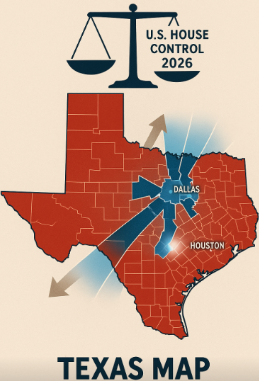Texas Republicans are betting mid-cycle redistricting will lock in gains before 2026, but Democrats see legal and political risks.
What to Know
- Republicans in Austin pushed through a mid-decade congressional map using their legislative majority and legal justifications tied to “population adjustments.”
- Catalist’s 2024 report suggests the new lines could give the GOP up to five additional House seats heading into 2026.
- Larry Sabato’s Crystal Ball points to Dallas-Fort Worth and Houston suburbs as the main battlegrounds reshaped to favor Republicans.
- Democrats are weighing lawsuits, but federal courts have signaled reluctance to intervene in partisan gerrymanders.
- Texas is setting the tone for other states considering aggressive mid-decade redraws.
In Texas politics, timing is everything. Republicans, still in firm control of the legislature and the governor’s mansion, moved aggressively this year to redraw the state’s congressional map. Typically, redistricting occurs once every decade after the census.
But in Texas, “mid-cycle adjustments” are now the new weapon. By redrawing maps just two years after the 2024 election, the GOP hopes to solidify its edge and potentially secure as many as five additional House seats.

Texas redistricting map highlights GOP advantage. Image Credit: Texas Tribune
This maneuver isn’t confined to Texas. Nationally, it signals the beginning of a redistricting arms race where states use every legal lever to redraw the lines whenever politically convenient. This move highlights a difficult truth for Democrats: despite some Democratic gains in suburban areas, Republicans are solidifying their position by controlling the redistricting process. For Republicans, it’s a way to build a firewall against what they know will be tough elections in 2026.
The Stakes
Control of the U.S. House in 2026 may hinge on a handful of districts in just a few states. Texas alone could shift the balance. Catalist’s 2024 post-election report showed that while Democrats gained modestly among younger Latino and Asian American voters in urban and suburban counties, Republicans tightened their grip in rural areas and maintained strong support among White non-college voters. The new map takes those demographic currents and bakes them into the political terrain.

Image created by DALL-E
The redistricting effort has expanded districts within the Dallas-Fort Worth Metroplex and Houston suburbs, areas where Democratic influence was growing, to encompass more Republican-leaning exurban counties. In effect, the GOP is draining Democratic votes from competitive districts and concentrating them in already-blue urban seats. The result: fewer competitive races and a likely net Republican gain.
The Players
Governor Greg Abbott and Texas Republicans insist the changes are about complying with population shifts and ensuring equal representation. Democrats and civil rights groups call it raw power politics. The Voting Rights Act challenges are already being discussed, particularly around the treatment of Black and Latino voters in Harris County, where lines were drawn in ways that appear to weaken minority voting power.

Governor Greg Abbott; image credit Texas.gov
Nationally, the Republican Party is watching closely. A five-seat gain in Texas would go a long way toward padding what is currently a slim House majority. For Democrats, the challenge is whether to engage in drawn-out court fights that may not produce results before 2026 or to retool their voter outreach in districts they believe are winnable, even under tougher maps.
Voter Impact
For ordinary Texans, the redraw means some voters will find themselves in dramatically different political landscapes. A resident of suburban Fort Bend County who was once in a competitive district may now be folded into a safely Republican seat, effectively muting their vote.
According to Catalist, Democratic strength among young Latino voters in Houston’s western suburbs was just beginning to translate into competitive numbers. The new lines cut those gains short, scattering these voters across multiple GOP-leaning districts.

Image created by DALL-E
Sabato’s Crystal Ball points to similar dynamics in Dallas-Fort Worth. In Collin and Denton counties, fast-growing suburbs with shifting demographics had become headaches for Republicans.
The new districts extend lines outward, pulling in more conservative rural voters and diluting Democratic growth. For campaigns, this reshuffling forces a recalibration: Democrats must now find new paths to 50 percent, while Republicans can run more comfortably with narrower bases.
Risks for Each Side
Republicans may be winning the short game, but there are risks. Demographic shifts in Texas are not slowing down. Younger, more diverse voters are reshaping suburbs at a pace that could still catch Republicans off guard in a wave year.
The Republican Party's heavy reliance on gerrymandering might bolster the Democratic argument that the GOP is manipulating the electoral system, potentially increasing voter engagement among younger progressives.
 Image by DALL-E
Image by DALL-E
For Democrats, the risks are immediate. If they focus entirely on lawsuits, they may miss the opportunity to sharpen their economic message in Texas suburbs where voters remain open to persuasion.
If Democrats engage with voters on inflation, housing affordability, and healthcare costs, they can be competitive on these issues, as Catalist's data indicates these are the primary concerns for these voters. Without a clear counter-strategy, Democrats risk being locked out of seats that could have been competitive.
Wrap Up
Texas has once again become the proving ground for how far a party will go to bend the rules of redistricting to its advantage. By moving mid-cycle, Republicans are rewriting the playbook and daring Democrats to stop them. If successful, the GOP could walk into 2026 with a five-seat cushion that reshapes the fight for the House.
The broader lesson is clear: redistricting is no longer a once-a-decade event but a constant campaign tool. The Texas case highlights a critical lesson for Democrats: effective messaging is insufficient on its own. They require a robust structural strategy to challenge congressional maps with the same vigor that Republicans use to draw them.
For Republicans, the Texas gamble could be the difference between holding the House or losing it in a cycle where everything else is up for grabs. What happens in Austin will echo far beyond the Lone Star State, shaping the battlefield of American politics for years to come.




.png)
